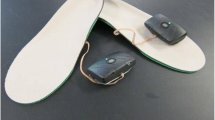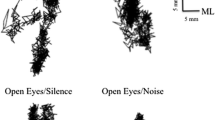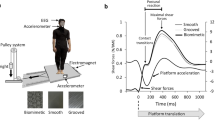Abstract
Light touch of a fingertip on an external stable surface greatly improves the postural stability of standing subjects. The hypothesis of the present work was that a vibrating surface could increase the effectiveness of fingertip signaling to the central nervous system (e.g., by a stochastic resonance mechanism) and hence improve postural stability beyond that achieved by light touch. Subjects stood quietly over a force plate while touching with their right index fingertip a surface that could be either quiescent or randomly vibrated at two low-level noise intensities. The vibratory noise of the contact surface caused a significant decrease in postural sway, as assessed by center of pressure measures in both time and frequency domains. Complementary experiments were designed to test whether postural control improvements were associated with a stochastic resonance mechanism or whether attentional mechanisms could be contributing. A full curve relating body sway parameters and different levels of vibratory noise resulted in a U-like function, suggesting that the improvement in sway relied on a stochastic resonance mechanism. Additionally, no decrease in postural sway was observed when the vibrating contact surface was attached to the subject’s body, suggesting that no attentional mechanisms were involved. These results indicate that sensory cues obtained from the fingertip need not necessarily be associated with static contact surfaces to cause improvement in postural stability. A low-level noisy vibration applied to the contact surface could lead to a better performance of the postural control system.






Similar content being viewed by others
Notes
It has been previously demonstrated that optimal configurations of the motion tracking system are able to produce measurements with precision and repeatability less than 1 μm (Schmidt et al. 2009). Nevertheless, additional measurements were performed (all with the subject touching the surface) with higher intensities of vibratory noise, so that measured displacements were within the resolution of the tracking system warranted by the manufacturer (100 μm). A linear relationship between the intensity of the noise signals delivered to the input of the shaker and both displacements and acceleration measures was observed. This confirmed that the estimation of RMS displacement values about 0.050 and 0.100 mm (corresponding to the 0.4 and 0.8 g noise RMS acceleration values, respectively) was indeed reliable.
Abbreviations
- ANOVA:
-
Analysis of variance
- AP:
-
Anterior–posterior
- BS:
-
Best stimulation
- COP:
-
Center of pressure
- COPap:
-
COP in the anterior–posterior axis
- COPml:
-
COP in the medio-lateral axis
- g :
-
Gravity of Earth
- HF:
-
High frequencies
- LF:
-
Low frequencies
- LT:
-
Light touch
- ML:
-
Medio-lateral
- PSD:
-
Power spectral density
- QS:
-
Quiet standing
- RMS:
-
Root mean square
- RMSap:
-
COPap RMS
- RMSml:
-
COPml RMS
- SD:
-
Standard deviation
- SR:
-
Stochastic resonance
- VMap:
-
COPap velocity
- VMml:
-
COPml velocity
- VS1:
-
Vibratory stimulation 1, at intensity 0.4 g
- VS2:
-
Vibratory stimulation 2, at intensity 0.8 g
References
Albertsen IM, Temprado JJ, Berton E (2010) Effect of haptic supplementation on postural stabilization: a comparison of fixed and mobile support conditions. Hum Mov Sci 29(6):999–1010
Benda JB, Riley PO, Krebs DE (1994) Biomechanical relationship between center of gravity and center of pressure during standing. IEEE Trans Rehabil Eng 2(1):3–10
Bezrukov SM, Vodyanoy I (1995) Noise-induced enhancement of signal transduction across voltage-dependent ion channels. Nature 378(6555):362–364
Caron O, Faure B, Breniere Y (1997) Estimating the centre of gravity of the body on the basis of the centre of pressure in standing posture. J Biomech 30(11–12):1169–1171
Clapp S, Wing AM (1999) Light touch contribution to balance in normal bipedal stance. Exp Brain Res 125(4):521–524
Cohen J (1988) Statistical power analysis for the behavioral sciences, 2nd edn. Lawrence Erlbaum Associates, Hillsdale
Collins JJ, Imhoff TT, Grigg P (1996) Noise-enhanced tactile sensation. Nature 383(6603):770
Collins JJ, Priplata AA, Gravelle DC, Niemi J, Harry J, Lipsitz LA (2003) Noise-enhanced human sensorimotor function. IEEE Eng Med Biol Mag 22(2):76–83
Cordo P, Inglis JT, Verschueren S, Collins JJ, Merfeld DM, Rosenblum S, Buckley S, Moss F (1996) Noise in human muscle spindles. Nature 383(6603):769–770
Douglass JK, Wilkens L, Pantazelou E, Moss F (1993) Noise enhancement of information transfer in crayfish mechanoreceptors by stochastic resonance. Nature 365(6444):337–340
Faisal AA, Selen LP, Wolpert DM (2008) Noise in the nervous system. Nat Rev Neurosci 9(4):292–303
Gage WH, Winter DA, Frank JS, Adkin AL (2004) Kinematic and kinetic validity of the inverted pendulum model in quiet standing. Gait Posture 19(2):124–132
Gluckman BJ, Netoff TI, Neel EJ, Ditto WL, Spano ML, Schiff SJ (1996) Stochastic resonance in a neuronal network from mammalian brain. Phys Rev Lett 77(19):4098–4101
Gravelle DC, Laughton CA, Dhruv NT, Katdare KD, Niemi JB, Lipsitz LA, Collins JJ (2002) Noise-enhanced balance control in older adults. Neuroreport 13(15):1853–1856
Hidaka I, Ando S, Shigematsu H, Sakai K, Setoguchi S, Seto T, Hirooka Y, Takeshita A, Yamamoto Y (2001) Noise-enhanced heart rate and sympathetic nerve responses to oscillatory lower body negative pressure in humans. J Neurophysiol 86(2):559–564
Holden M, Ventura J, Lackner JR (1994) Stabilization of posture by precision contact of the index finger. J Vestib Res 4(4):285–301
Jaramillo F, Wiesenfeld K (1998) Mechanoelectrical transduction assisted by Brownian motion: a role for noise in the auditory system. Nat Neurosci 1(5):384–388
Jeka JJ, Lackner JR (1994) Fingertip contact influences human postural control. Exp Brain Res 100(3):495–502
Jeka JJ, Lackner JR (1995) The role of haptic cues from rough and slippery surfaces in human postural control. Exp Brain Res 103(2):267–276
Jeka JJ, Schoner G, Dijkstra T, Ribeiro P, Lackner JR (1997) Coupling of fingertip somatosensory information to head and body sway. Exp Brain Res 113(3):475–483
Johannsen L, Wing AM, Hatzitaki V (2007) Effects of maintaining touch contact on predictive and reactive balance. J Neurophysiol 97(4):2686–2695
Krishnamoorthy V, Slijper H, Latash ML (2002) Effects of different types of light touch on postural sway. Exp Brain Res 147(1):71–79
Lackner JR, Rabin E, DiZio P (2001) Stabilization of posture by precision touch of the index finger with rigid and flexible filaments. Exp Brain Res 139(4):454–464
Liu W, Lipsitz LA, Montero-Odasso M, Bean J, Kerrigan DC, Collins JJ (2002) Noise-enhanced vibrotactile sensitivity in older adults, patients with stroke, and patients with diabetic neuropathy. Arch Phys Med Rehabil 83(2):171–176
Manjarrez E, Diez-Martinez O, Mendez I, Flores A (2002) Stochastic resonance in human electroencephalographic activity elicited by mechanical tactile stimuli. Neurosci Lett 324(3):213–216
Martinez L, Perez T, Mirasso CR, Manjarrez E (2007) Stochastic resonance in the motor system: effects of noise on the monosynaptic reflex pathway of the cat spinal cord. J Neurophysiol 97(6):4007–4016
McDonnell MD, Abbott D (2009) What is stochastic resonance? Definitions, misconceptions, debates, and its relevance to biology. PLoS Comput Biol 5(5):e1000348
Mezzarane RA, Kohn AF (2008) Postural control during kneeling. Exp Brain Res 187(3):395–405
Morse RP, Evans EF (1996) Enhancement of vowel coding for cochlear implants by addition of noise. Nat Med 2(8):928–932
Moss F, Ward LM, Sannita WG (2004) Stochastic resonance and sensory information processing: a tutorial and review of application. Clin Neurophysiol 115(2):267–281
Oliveira LF, Simpson DM, Nadal J (1996) Calculation of area of stabilometric signals using principal component analysis. Physiol Meas 17(4):305–312
Priplata A, Niemi J, Salen M, Harry J, Lipsitz LA, Collins JJ (2002) Noise-enhanced human balance control. Phys Rev Lett 89(23):238101
Priplata AA, Niemi JB, Harry JD, Lipsitz LA, Collins JJ (2003) Vibrating insoles and balance control in elderly people. Lancet 362(9390):1123–1124
Priplata AA, Patritti BL, Niemi JB, Hughes R, Gravelle DC, Lipsitz LA, Veves A, Stein J, Bonato P, Collins JJ (2006) Noise-enhanced balance control in patients with diabetes and patients with stroke. Ann Neurol 59(1):4–12
Reginella RL, Redfern MS, Furman JM (1999) Postural sway with earth-fixed and body-referenced finger contact in young and older adults. J Vestib Res 9(2):103–109
Richardson KA, Imhoff TT, Grigg P, Collins JJ (1998) Using electrical noise to enhance the ability of humans to detect subthreshold mechanical cutaneous stimuli. Chaos 8(3):599–603
Rogers MW, Wardman DL, Lord SR, Fitzpatrick RC (2001) Passive tactile sensory input improves stability during standing. Exp Brain Res 136(4):514–522
Ross SE (2007) Noise-enhanced postural stability in subjects with functional ankle instability. Br J Sports Med 41(10):656–659 discussion 659
Schmidt J, Berg DR, Ploeg H-L (2009) Precision, repeatability and accuracy of optotrak® optical motion tracking systems. Int J Exp Comput Biomech 1(1):114–127
Sheskin DJ (2007) Handbook of parametric and nonparametric statistical procedures. Chapman & Hall/CRC Press, Boca Raton
Stacey WC, Durand DM (2000) Stochastic resonance improves signal detection in hippocampal ca1 neurons. J Neurophysiol 83(3):1394–1402
Stocks NG (2000) Suprathreshold stochastic resonance in multilevel threshold systems. Phys Rev Lett 84(11):2310–2313
Tabachnick BG, Fidell LS (2007) Using multivariate statistics. Pearson Education, Boston
Ward LM, Neiman A, Moss F (2002) Stochastic resonance in psychophysics and in animal behavior. Biol Cybern 87(2):91–101
Wiesenfeld K, Moss F (1995) Stochastic resonance and the benefits of noise: from ice ages to crayfish and squids. Nature 373(6509):33–36
Acknowledgments
This research was funded by CNPq. The first author is a recipient of a fellowship from FAPESP, grant #2007/03608-9. We are grateful to Sandro A. Miqueleti for his invaluable technical support.
Author information
Authors and Affiliations
Corresponding author
Rights and permissions
About this article
Cite this article
Magalhães, F.H., Kohn, A.F. Vibratory noise to the fingertip enhances balance improvement associated with light touch. Exp Brain Res 209, 139–151 (2011). https://doi.org/10.1007/s00221-010-2529-3
Received:
Accepted:
Published:
Issue Date:
DOI: https://doi.org/10.1007/s00221-010-2529-3




